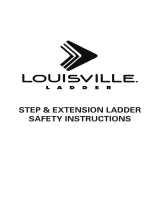
Choosing the Ladder Material
Your choice of ladders is also influenced by the environment of your work site. For example, you must use a
clean, dry fiberglass ladder if you are working near sources of electricity. That’s because metal ladders can
easily conduct electricity to you, causing serious injury or death. Don’t forget that sweat, oil, paint, caulk,
and grease can conduct electricity. Make certain your ladder is free of these substances and any other dirt
or debris.
L: LOOK FOR DAMAGED OR MISSING PARTS
Always check for damage before using any ladder. Do not use a damaged ladder. Conduct your inspection
before you leave for the job site.
1. Begin at the bottom, making sure the feet are not broken or malfunctioning and that the slip-resistant
pads are secure.
2. Inspect the ladder for cracks, bends, and splits on side rails, rungs, and steps.
3. Check all rung/step-to-side rail connections, as well as hardware, fittings, and accessories. Make sure
both rung locks are in working order.
4. Test the rope and pulley for smooth operation. Replace the rope if frayed or partially cut.
5. All pivotal connections and the rung-locks should be well-lubricated.
6. All bolts and rivets should be secure. Never use a ladder if any bolts or rivets are missing or if the joints
between the steps (or rungs) and the side rails are not tight.
7. Make sure the ladder (particularly the steps and rungs) is free of foreign materials such as
oil and grease.
8. If you’re using a stepladder, make sure the spreader braces are not bent, are secure
and working properly.
Use a ladder-inspection chart as a guide for evaluating the safety of a ladder.
Remember to inspect the ladder before you travel to the job site, because once
you’re there you’ll be tempted to use the ladder regardless of its condition.
Always mark unsafe ladders by using a damaged-ladder tag (see sample
illustration).
Be sure to store damaged ladders away from usable ladders. Have them repaired
as soon as possible. Destroy unrepairable ladders immediately.
TRANSPORTING A LADDER
Accidents can happen while transporting the ladder to the job site. A ladder is
long and awkward, and can cause injuries and property damage during transport.
When possible, two people should carry an extension ladder. If you carry it
yourself, keep the front end of the ladder slightly higher than the back end.
Never move or reposition an extension ladder without completely retracting the fly
section. Failure to do so can cause serious injury or death.
Secure both ends of a ladder when transporting it on a vehicle. Use care when placing ladders onto or
removing from ladder racks.










